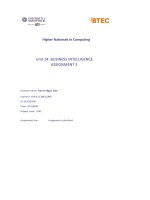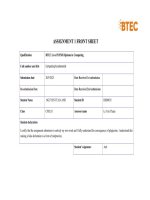btec level 5 hnd diploma in computing unit 3 professional practice
Bạn đang xem bản rút gọn của tài liệu. Xem và tải ngay bản đầy đủ của tài liệu tại đây (2.62 MB, 24 trang )
<span class="text_page_counter">Trang 1</span><div class="page_container" data-page="1">
ASSIGNMENT 1 Professional Practice
JUNE 19, 2020
FPT </div><span class="text_page_counter">Trang 2</span><div class="page_container" data-page="2"><b>Issue date 16<small>th</small> January 2020Submission date </b> 8<small>th</small> February 2020
<b>IV name and date </b> Vo Minh Truc
<b>Submission format Part 1: Requirements </b>
The submission is in the form of a completed <b>individual portfolio folder</b>, including the tasks set out in the Assignment Brief. This assignment involves group work but each student should submit an individual portfolio folder.
<b>Part 1: A four-day training schedule (using project management software) and a training package to </b>
include a range of activities, seminars, workshops, team-building activities and break-out sessions.
<b>Part 2: Ten-minute Microsoft® PowerPoint® style presentation with interactive links to suitable sites and </b>
an activity sheet (Your research should be referenced using the Harvard referencing system. The recommended word limit is 500 words, including speaker notes, although you will not be penalized for exceeding the total word limit).
</div><span class="text_page_counter">Trang 3</span><div class="page_container" data-page="3"><b>Part 3: A written evaluation of your performance in this task and your contribution to the team. You are </b>
required to make use of <b>headings, paragraphs, subsections and illustrations as appropriate, and all work </b>
must be supported with research and <b>referenced using the Harvard referencing system</b>. The recommended word limit is 500 1,000 words, although you will not be penalized for exceeding the total –word limit.
<b>Assignment Brief and Guidance </b>
You have been asked to support your training and development manager with the planning and implementation of a professional development event targeted at internal employees within the organization that you work in.
The training event is scheduled over a four days (4) period at a nearby residential center, and will include –a <b>number of workshops coaching sessions</b>, and <b>team-building activities. The center requires a schedule </b>
of the types of activities proposed so that plans can be finalized. In addition, any guest speakers or motivational coaches will also require a minimum of three weeks9 notice for all bookings.
You have also been asked to design and deliver a workshop as part of the training event based on the dynamics of team working.
<b>Working in small groups (3-4 per group): </b>
<b>1. Produce a professional event schedule (using project management software) and WBS (work </b>
breakdown structure) that identifies planning and resourcing prior to the four-day event. In addition, design a training pack to include a range of activities, seminars, workshops, team- building activities and break-out sessions.
<b>2. Design ten minutes workshop session </b>based on 8team dynamics9 to include a presentation, interactive links to suitable sites and an activity sheet that will require delegates to take part in some form of team-building task.
<b>Working individually: </b>
</div><span class="text_page_counter">Trang 4</span><div class="page_container" data-page="4">3. Following the event, your training and development manager has asked you to provide some
<b>feedback. Produce a written team evaluation of the effectiveness</b> and <b>application of interpersonal skills during the design and delivery process. You should also include a self- </b>
evaluation of your performance in this project and your contribution to the team you worked in. Explain what kind of skills and qualities you gain from this project and what values you added to your personal development plan.
4. Identify the problems may have and produce a report on discussing problem-solving and its importance in planning and running an event. Your report should include a discussion of various problem-solving techniques and justify the solution methodologies used during your project. You should also include a critique of the application of critical reasoning and your experiences of it.
<b>Part 3: Learning outcomes: LO1, LO2 </b>
<b>Assessment Criteria </b>
<small>LO1: Demonstrate a range of interpersonal and transferable communication skills to a target audience </small>
<b>P1 Demonstrate, using different </b>
<small>communication styles and formats, that you can effectively design and deliver a training event for a given target audience. </small>
<b>P2 Demonstrate that you have used </b>
<small>effective time management skills in planning an event. </small>
<b>M1 Design a professional </b>
<small>schedule to support the planning of an event, to include contingencies and justifications of time allocated. </small>
<small>D1 Evaluate the effectiveness and application of interpersonal skills during the design and delivery of a training event. </small>
<small>LO2 Apply critical reasoning and thinking to a range of problem-solving scenarios </small>
</div><span class="text_page_counter">Trang 5</span><div class="page_container" data-page="5"><b>P3 Demonstrate the use of different </b>
<small>problem-solving techniques in the design and delivery of an event. </small>
<small>M2 Research the use of different problem-solving techniques used in the design and delivery of an event. </small>
<small>D2 Critique the process of applying critical reasoning to a given task/activity or event. </small>
<small>P4 Demonstrate that critical reasoning has been applied to a given solution. </small>
<small>M3 Justify the use and application of a range of solution methodologies. </small>
</div><span class="text_page_counter">Trang 6</span><div class="page_container" data-page="6">Table of Contents
<b>A.INTRODUCTION</b> ... 7
<b>B. Demonstrate, using different communication styles and formats, that you can effectively design and deliver a training event for a given target audience. ... 7 </b>
<b>I. Definition and the importance of communication skill: ... 7 </b>
<b>II. Verbal communication: ... 8 </b>
<b>III. Non-verbal communication:... 9 </b>
<b>IV. Communication in the group:... 11 </b>
<b>C. Demonstrate that you have used effective time management skills in planning an event. ... 13 </b>
<b>I. Definition and the importance of Time management skills: ... 13 </b>
<b>1.1. What is time management skills? ... 13 </b>
<b>1.2. The importance of time management skills: ... 14 </b>
<b>II. Planning a training event: ... 14 </b>
<b>2. Planning a training event: ... 14 </b>
<b>2.1. Name of the training program: ... 14 </b>
<b>2.2. Goals of the training program: ... 14 </b>
<b>D. Demonstrate the use of different problem-solving techniques in the design and delivery of an event. ... 16 </b>
<b>I. Definition and the importance of Problem-solving: ... 16 </b>
<b>II. Some techniques and tools for the problem solving: ... 16 </b>
<b>III. Problems and solutions in the training event: ... 18 </b>
<b>E. Demonstrate that critical reasoning has been applied to a given solution. ... 19 </b>
<b>I. Definition and the importance of critical reasoning: ... 19 </b>
<b>II. Apply to a given solution: ... 20 </b>
</div><span class="text_page_counter">Trang 7</span><div class="page_container" data-page="7"><b>G.CONCLUSION:</b> ... 21
<b>H. CRITICAL EVALUATION: ... 21 </b>
<b>I. My strengths and weaknesses: ... 21 </b>
<b>1. My strengths: ... 21 </b>
<b>2. My weakness and how I improved it ... 21 </b>
<b>II. Which grade do I think I deserve? ... 22 </b>
<b>References ... 23 </b>
Figure 1 - Communication Skills - Image source: improve-them ... 7
2 - GANTT chart ... 15
Table 1 - Roles and contributions of each member of my team ... 21
</div><span class="text_page_counter">Trang 8</span><div class="page_container" data-page="8"><b>A. INTRODUCTION </b>
<b>B. Demonstrate, using different communication styles and formats, that you can effectively </b>
<b>design and deliver a training event for a given target audience. </b>
I. Definition and the importance of communication skill:
<b> Definition: </b>
Communication skills are the capacities you use when giving and getting various types of information. Some examples include communicating ideas, feelings, or what9s happening around you. Communication skills involve listening, talking, observing, and empathizing. It is additionally useful to comprehend the distinctions in how to communicate through up face-to-face and personal cooperation9s, telephone discussions, and digital communications, similar to email, and social media. (Indeed, 2020)
<b> The importance of communication skill: </b>
</div><span class="text_page_counter">Trang 9</span><div class="page_container" data-page="9">II. Verbal communication:
<b> Definition: </b>
Verbal communication is the utilization of words to impart data to others. It can, therefore, include both spoken and written communication. In any case, numerous individuals utilize the term to describe only spoken communication. The verbal element of communication is all about the words that you choose, and how they are heard and interpreted. (Skillsyouneed, 2013)
<b> Basic verbal communication skills: </b>
Effective speaking: It covers three main areas: The words you choose.
How do you say them?
How do you strengthen them with
Active listening: When we convey, we will spend more effort to consider what we will say than tune in to other people. Effective listening is significant for acceptable verbal communication. There are numerous ways you can guarantee that you hear better:
Be prepared to listen. Think it out.
Focus on the main direction of the speaker's message. Avoid distractions.
Be objective.
Don't try to think about your next question while others are providing information. Do not focus on one or two points at the expense of others.
Do not stereotype the speaker.
<b> Improve verbal communication: </b>
Reinforcement: is the use of words of encouragement in addition to nonverbal cues such as nodding, warm facial expressions, and maintaining eye contact. It can:
Encourage others to take an interest in conversations (especially in group work). Show enthusiasm for what others need to say.
Paving the way for the development and/or maintenance of relationships. Dispel fear and reassure.
</div><span class="text_page_counter">Trang 10</span><div class="page_container" data-page="10">Showing warmth and openness.
Reduce shyness or nervousness in us and others.
Questioning: is the means by which we get data from others on explicit themes. There are two fundamental sorts of inquiries:
Closed questions: tend to look for only one or two-word answers (usually simply 8Yes, or No9). Therefore, they limit the scope of the reaction.
Open questions: require further discussion and elaboration. In this way, they expand the extent of the reaction.
Reflecting and clarifying: often involves interpreting the message that the speaker communicates to you with your words. You need to try to capture the nature of the events and emotions that are expressed, and convey your understanding back to the speaker. This is a valuable ability on the grounds that:
You can check that you understand the message clearly.
The speaker receives feedback on how to receive the message and can then clarify or expand if they wish.
It shows concern and respect for what others say.
You are demonstrating that you are thinking about the perspectives on others.
III. Non-verbal communication:
<b> Definition: </b>
Non-verbal communication including outward appearances, tone, and pitch of voice, motions are displayed through body language and physical distance between communicators.
<b> Types of non-verbal communication: </b>
There is a wide range of sorts of nonverbal correspondence. These include:
<b> Exercise the body. </b>
For instance, hand motions or gestures, or head shaking, are frequently the easiest
</div><span class="text_page_counter">Trang 11</span><div class="page_container" data-page="11"><b> Posture. </b>
The manner in which you stand or sit, regardless of whether your arms are crossed.
<b> Eye contact. </b>
Determines the level of trustworthiness and reliability.
<b> Para-language, or aspects of the voice beyond words. </b>
Such as pitch, tone, and discourse rate.
<b> Intimacy or personal space. </b>
Determines the level of closeness, and differs extraordinarily by culture.
<b> The importance of using non-verbal communication: </b>
Non-verbal communication helps people to:
<b> Consolidate or modify what is said in words. </b>
For example, people might nod vigorously by saying "Yes" to emphasize that they concur with others.
<b> Communicate about their emotional state. </b>
For example, your outward appearances, voice, and non-verbal communication can frequently tell people exactly how you feel, regardless of whether you scarcely state a word.
</div><span class="text_page_counter">Trang 12</span><div class="page_container" data-page="12"><b> Identify or strengthen relationships between people. </b>
For instance, in the event that you've at any point seen a couple talking, you may see that they tend to 'reflect each other's body language. They hold hands in similar positions, they smile at the same time and they turn to face each other more fully.
<b> Give feedback to others. </b>
For instance, a grin and a gesture tell somebody that you are listening and you concur with what they are stating.
<b> Adjust the flow of communication. </b>
For instance, a strong nod and closed lips indicate that we don't have anything more to state.
IV. Communication in the group:
Achieve a mission. Build and maintain a team. Personal development/help.
<b> Benefits of group learning: </b>
Experience, skill, or knowledge of others. Support, encouragement, responsibility. Share the work.
Increased understanding. Different views.
<b> Signs of an effective group: </b>
</div><span class="text_page_counter">Trang 13</span><div class="page_container" data-page="13">Clear, relevant goals. Open communication. Cooperation.
Members are liable for their conduct. Processes for decisions established. Problems confronted openly. Conflict resolved constructively.
<b> Presentation in the group: Purpose and context: </b>
To inform, train, convince, engage, sell, or perform? Who is the audience?
How much time do you have? Where is the place? Formal or informal?
<b> Planning and preparation: </b>
Relevance to objectives and audience. Collect documents related to the message.
Structure of the material: introduction (get attention), middle (logic, chunk), end (summarize the main points).
Use the notes. Use visual means. Practice.
<b> Delivery: </b>
Check room, time, equipment.
Self-awareness: voice, non-verbal communication, certainty. Handling questions.
Tip: Be aware of verbal and non-verbal language.
<b> Overcoming nerves: </b>
</div><span class="text_page_counter">Trang 14</span><div class="page_container" data-page="14">Reasons for anxiety: the absence of experience, planning, preparation, and enthusiasm; negative self-talk.
Overcoming the nerves: be over-prepared, practice, use relaxation techniques, positive deduction, consider any circumstance, keep away from pressure and avoid stress.
<b>C. Demonstrate that you have used effective time management skills in planning an event. </b>
I. Definition and the importance of Time management skills:
1.1. What is time management skills?
<b> Time management is simply defined as time management to get the most out of it. Some of the most important time management skills include: </b>
<b> Organization: Keeping organized can help you maintain a clear picture of what you </b>
need to accomplish and when.
<b> Prioritization: Assessing every one of your obligations on a need level is vital to turn </b>
into a decent time director.
<b> Set goals: Setting goals is the initial step to turning into a decent time director. goals </b>
setting permits you to plainly comprehend your ultimate objective and precisely what you have to organize to achieve it.
<b> Communication: Develop solid communication skills that can permit you to explain </b>
your arrangements and objectives with the individuals you work with.
<b> Planning: A basic part of time management is planning. Being effective in planning </b>
your day, meetings, and how you will accomplish everything will help you keep abreast of your schedule.
<b> Delegation: Being a good time manager means that just getting the job done will help </b>
you and your company accomplish its goals. In spite of the fact that this aptitude is frequently performed by managers, you can also practice delegated tasks if you are managing a project.
<b> Managing stress: When you practice good time management, you ought to likewise </b>
focus on your psychological well-being. Aggressive handling can assists you stay
</div><span class="text_page_counter">Trang 15</span><div class="page_container" data-page="15">1.2. The importance of time management skills:
<b> Time management skills are important in light of the fact because they assist you in </b>
organizing your work in a manner that permits you to achieve your goals.
<b> For instance, if you will probably find a new line of work, you need t time to update </b>
your resume, look for opportunities, apply for a job, go after a position, research organizations, what's more, get ready for interviews. Taking a specific amount of time each day will assist you in finishing the steps needed to get a job.
<b> Managing your time well lets you have space to be innovative and proactive about your </b>
objectives. At the point When you have a specific time set aside to complete your task, you can likewise take the time to think about the big picture for yourself and your company.
II. Planning a training event:
2. Planning a training event: 2.1. Name of the training program:
<Communicate with your customers effectively.=
2.2. Goals of the training program:
To teach new team members how to handle challenging customer calls more effectively.
</div>








